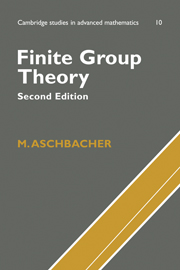Book contents
- Frontmatter
- Contents
- Preface
- 1 Preliminary results
- 2 Permutation representations
- 3 Representations of groups on groups
- 4 Linear representations
- 5 Permutation groups
- 6 Extensions of groups and modules
- 7 Spaces with forms
- 8 p-groups
- 9 Change of field of a linear representation
- 10 Presentations of groups
- 11 The generalized Fitting subgroup
- 12 Linear representations of finite groups
- 13 Transfer and fusion
- 14 The geometry of groups of Lie type
- 15 Signalizer functors
- 16 Finite simple groups
- Appendix
- References
- List of Symbols
- Index
13 - Transfer and fusion
Published online by Cambridge University Press: 05 June 2012
- Frontmatter
- Contents
- Preface
- 1 Preliminary results
- 2 Permutation representations
- 3 Representations of groups on groups
- 4 Linear representations
- 5 Permutation groups
- 6 Extensions of groups and modules
- 7 Spaces with forms
- 8 p-groups
- 9 Change of field of a linear representation
- 10 Presentations of groups
- 11 The generalized Fitting subgroup
- 12 Linear representations of finite groups
- 13 Transfer and fusion
- 14 The geometry of groups of Lie type
- 15 Signalizer functors
- 16 Finite simple groups
- Appendix
- References
- List of Symbols
- Index
Summary
If G is a finite group, H ≤ G, and α: H → A is a homomorphism of H into an abelian group A, then it is possible to construct a homomorphism V : G → A from α in a canonical way. V is called the transfer of G into A via α. If we can show there exists g ∈ G – ker(V), then, as G/ker(V) is abelian, g ∉ G(1) the commutator group of G. In particular G is not nonabelian simple.
It is however in general difficult to calculate gV explicitly and decide whether g ∈ ker(V). To do so we need information about the fusion of g in H; that is information about gG∩H. Hence chapter 13 investigates both the transfer map and techniques for determining the fusion of elements in subgroups of G.
Section 38 contains a proof of Alperin's Fusion Theorem, which says that p-local subgroups control the fusion of p-elements. To be somewhat more precise, if P is a Sylow p-subgroup of G then we can determine when subsets of P are fused in G (i.e. conjugate in G) by inspecting the p-locals H of G with P ∩ H Sylow in H.
Section 39 investigates normal p-complements. A normal p-complement for a finite group G is a normal Hall p′-subgroup of G. Various criteria for the existence of such objects are generated, The most powerful is the Thompson Normal p-Complement Theorem, which is used in the next section to establish the nilpotence of Frobenius kernels.
- Type
- Chapter
- Information
- Finite Group Theory , pp. 197 - 208Publisher: Cambridge University PressPrint publication year: 2000



